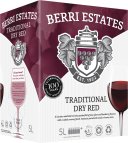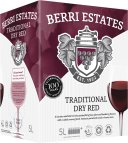Château Mouton Rothschild Pauillac
Château Mouton Rothschild is the work of one man, the legendary Baron Philippe, who is solely responsible for this giant of Bordeaux. Taking charge in 1923 until his death in 1988, he created something the world will always be in debt for. He also started the tradition of getting an artist to design a label for every vintage, a tradition that continues to this day. In 2009, the wine almost transcends perfection. A quite low alcohol percentage given the ripeness of the fruit, the bouquet is reminiscent of cigar box and graphite with violets and cassis playing a part. The palate is both restrained and concentrated, a impressive result indeed. The structure of the wine is hidden somewhat by the exuberant fruit, yet it is that structure that will see this extraordinary wine cellar for the good part of half a century!
Berri Estates Traditional Dry Red
This is a soft and approachable red wine which pays homage to Claret's starring role during the inception of Australia's wine industry.
Spinifex Papillon
Spinifex Papillon is a vibrant and luscious red from the Baross Valley that is a blend of Grenache, Cinsault and Mataro. Made in the typical modern Australian mould, the Papillon is bright and aromatic with lifted cherry, red currant and spicy raspberry. A very perfumed wine with earthy flavours of beetroot and white pepper which lends itself to being a terrific food style wine with lovely acid structure and a medium weight.
Domaine du Vieux Telegraphe Châteauneuf-du-Pape La Crau
For this Grenache blend, grapes are hand-picked, with double sorting at the vine, followed by a third sorting at the winery. Gentle crushing and selective destemming, followed by 25-40 days' traditional fermentation in temperature-controlled stainless-steel and wooden vats. Pneumatic pressing, then systematic malolactic fermentation. A classic red Châteauneuf-du-Pape by Domaine du Vieux Telegraphe, very fine and elegant. The best vintages will age for 25 years and more.
Château Margaux
A 1st Growth of the highest order, Château Margaux is one of the original 1st growths classified in the Médoc and is arguably the most important of the region. Producing only some 33,000 cases of predominantly Cabernet Sauvignon, Margaux consistently produces wines that are among the finest examples of the vintage. 2009 is regarded as one of the finest in recent memory in the region and 'normal' wines form the Margaux appellation are being heralded as truly exceptional. One can only speculate how magnificent the Château Margaux will be in 15-20 years time, if one can be patient enough!
Château Latour Pauillac
Château Latour is the epitome of power and bold concentration that is Pauillac. With a high proportion of Cabernet Sauvignon, the brilliant close knit tannin complimenting the vibrant cassis driven fruit is something to behold. It is often said that buyers of Latour worry about the wines they purchase will outlive them quite considerably such is the pedigree of such a wine. This is a definite concern for the 2009 vintage which is being reported as being the very best in living memory. The wine itself is a masterclass in concentration and power only with a robust and joyful front and mid-palate. Notes of blackberry and dark plum dance along with secondary characters of subtle oak and pencil shavings. A rambunctuous back palate that is almost thick and viscous that is truly forboding. Robert Parker Jnr has been quoted as saying
Château Lascombes Margaux
Château Lascombes was a small property by Bordeaux standards up until 1951, which then grew to beyond its means until the most recent ownership change which has seen better fruit selection and a creation of a second label to produce an estate wine of purity and concentrated flavours. Using the talents of Dr Alain Reynaud and Michel Rolland the wines continue to impress in recent years, namely this spectacular 2009 vintage which is proving to be one of the greatest vintages in the past 100. Even at this early stage the Lascombes looks superb with balance between power and opulence treading a near perfect line.
Petaluma Coonawarra
A stylish blend of Cabernet Sauvignon and Merlot, with a touch of Shiraz and Petit Verdot, from low yielding vineyards have produced another wine of elegance and class. Blackberry, mint and tobacco flavours are framed by fine tannin. The Shiraz adds some supple softness and the Petit Verdot adding aromatic lift. Another triumph!
Yarra Yering Dry Red No 1
One of Victoria's true heritage wines, Yarra Yering Dry Red No.1 is primarily a blend of Cabernet Sauvignon with Merlot, Malbec and a touch of Petit Verdot. Planted on a historic Yarra Valley site by the late Dr Bailey Carrodus, this wine is full of complex aromas of plum and berry which is followed by rich fruits with an oak and cedar slant. A wine drinking well now and value for the true wine lover.
Château Palmer Margaux
Château Palmer is considered one of the worlds first 'Super Seconds' (although actually classified as a third growth), a term relating to the top echelon of producers that fall outside of the ancient 1st Growth classification. Margaux's Château Palmer was named after a British general who fought under Wellington. It has been stated by quite a few wine critics that this could possibly be the finest Château Palmer ever produced. An amazing claim considering how phenomenal the 2005 was and is yet to be. Masses of concentrated aromas and flavours that will keep your senses entertained for hours on end. A truly remarkable achievement that will repay the patient cellarer over the next 30 years.

























